October is Breast Cancer Awareness Month
After skin cancer, breast cancer is the most common cancer diagnosed in women in the United States. According to the National Breast Cancer Foundation, one in eight women will have breast cancer at some point during her lifetime. The organization also notes that an estimated 43,550 women will die from breast cancer in the U.S. this year.
October 1st marks the start of Breast Cancer Awareness Month, a campaign started in 1985 as a way to raise awareness for breast cancer, as well as to fund research to find a cure.
What Is Breast Cancer?

Breast cancer is a disease in which malignant (cancer) cells form in the tissues of the breast. While there is no cure yet for breast cancer, there are treatments available to remove, shrink, or slow the growth of tumors.
This specific type of cancer can occur in both men and women. However, breast cancer is far more common in women, as less than one percent of all breast cancer cases occur in men.
While breast cancer may be more prevalent in women, men with this type of cancer have a higher mortality rate than women. This is oftentimes due to the lack of awareness among men regarding the disease.
The Importance of Early Detection and Education
The month is also a critical time for early detection and education regarding breast cancer. For women, breast cancer amounts to 30% of all new cancer diagnoses in the United States, and some women are genetically at a much higher risk. Breast Cancer Awareness Month reminds women, and men, to be proactive when it comes to breast cancer.

According to the American Cancer Society, when breast cancer is detected early in the localized stage, the 5-year survival rate is 99 percent.
How to Practice Early Detection:
1. Conducting a Self-Exam– Medical professionals encourage women to do a self-exam at least once a month. This will allow women to be familiar with their breasts, which will make it easier to recognize any lumps or other changes.
If you find a lump, schedule an appointment with your doctor. There is no need to panic strictly about a lump though, as 8 out of 10 lumps are not cancerous.
2. Knowing the Symptoms and Signs– It is important to know the symptoms to look out for regarding breast cancer. Visit this page to learn more.
3. Clinical Breast Exams– Along with self-exams, make sure you have clinical breast exams done by your doctor at your annual physical.
4. Mammograms– Women 40 and older should have mammograms every 1 or 2 years. In addition, if you are younger than 40 but have risk factors for breast cancer, you should ask your healthcare professional about doing a mammogram.
Resources for Research and Treatment
At GrantWatch.com., we have a category specifically for health and medical grants. In this category, grants are available for cancer research and treatment. In honor of Breast Cancer Awareness Month, GrantWatch is sharing 10 grants focused on cancer research and treatment below.
10 Grants in Honor of Breast Cancer Awareness Month
- Grants are available to USA physicians for cancer-related research. Funding will speed up the process of turning research discoveries into better treatments and therapy for patients.
- Grants are also available to New Jersey, New York, and Connecticut institutions to support cancer surgery fellowships for doctors.
- Funding is available to Israeli individuals diagnosed with breast cancer for financial assistance.
- There are also grants of up to $5,000 available to Texas nonprofits for cancer-related medical research, specifically focused on finding a cure.
- USA researchers affiliated with nonprofit institutions can apply for grants to support cancer research.
- Grants are also available to New York and Connecticut nonprofits in eligible regions to support services for breast cancer patients.
- There are also grants for New York nonprofits, agencies, IHEs, and tribes for breast health, education, and support.
- Additionally, grants of $500 and grants of $750 are available to breast cancer patients to offset costs related to treatment.
- Grants are offered to Connecticut and New York nonprofits in eligible locations to assist underserved women with breast cancer.
- Finally, there are grants available to USA nonprofits and individuals for research on the relationship between cancer care and healthcare policies.
Additional Breast Cancer Resources
- The Centers for Disease Control (CDC) has an early detection and screening program for uninsured or underinsured low-income women.
- Many states also have early-detection programs. You can call your county health department to see if you qualify.
- The American Cancer Foundation has a financial assistance program for the uninsured.
- The Patient Advocate Foundation is a national nonprofit that seeks to help protect patients and help them get connected to the medical information that they need.
- Medical Assistance Tool is a platform that helps match patients with cost-sharing programs and assistance programs to help them cover key medications.
GrantNews Notes
Are you looking for more grants like the ones on this list? Check out our full health and medical grant category at GrantWatch.com.
Also, make sure to give your organization the gift of GrantWatch. Signing up to be a paid subscriber, will provide you with access to more than 6,000 grants for nonprofits, small businesses, and individuals. This includes full eligibility criteria, contact information for grant funders, and application links.

